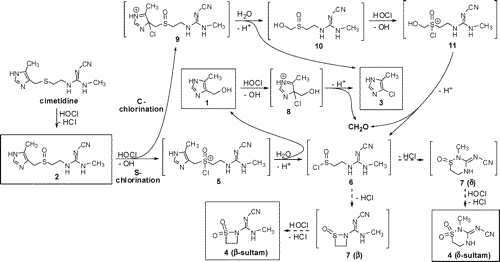09/7/2007
Transforming
a pollutant from bad to worse
Recent Research from the group of Professor
Kris McNeill.

Scheme
1. This scheme shows the proposed transformation pathways that take cimetidine
to its major products.
Recent
research by graduate student Jeff Buth shows that chlorination of cimetidine,
a commonly used heartburn drug found in wastewater, leads to unexpected
products. Some of these products, including 4-chloro-5-methylimidazole
(3 in
Scheme 1), are expected to have a greater ecological impact than the parent
compound. This result poses a dilemma for water utilities as chlorination
is a widely used disinfection method for wastewater and “micropollutants”
such as cimetidine are newly recognized wastewater contaminants. This research
is part of a long-standing collaboration between Kris
McNeill of the Department
of Chemistry and Professor Bill
Arnold of the Department of Civil Engineering
on the fate of pharmaceutical pollutants in the aquatic environment.
You
can read more about this research in the online edition of Environmental
Science and Technology. Unexpected
Products and Reaction Mechanisms of the Aqueous Chlorination of Cimetidine
Jeffrey
M. Buth, William A. Arnold, and Kristopher McNeill
Environmental Science and Technology, 2007, ASAP. [LINK]
|